
How to Use LoRa 433mhz SX1278 Ra-02: Examples, Pinouts, and Specs
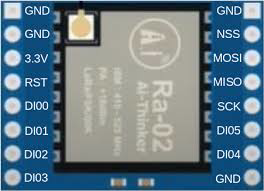
 Design with LoRa 433mhz SX1278 Ra-02 in Cirkit Designer
Design with LoRa 433mhz SX1278 Ra-02 in Cirkit DesignerIntroduction
The LoRa 433MHz SX1278 Ra-02 is a long-range, low-power wireless transceiver module designed for Internet of Things (IoT) applications. Operating on the 433 MHz frequency, this module leverages LoRa (Long Range) modulation technology to enable communication over several kilometers while maintaining minimal power consumption. It is ideal for applications requiring reliable, long-distance communication in environments with obstacles or interference.
Explore Projects Built with LoRa 433mhz SX1278 Ra-02
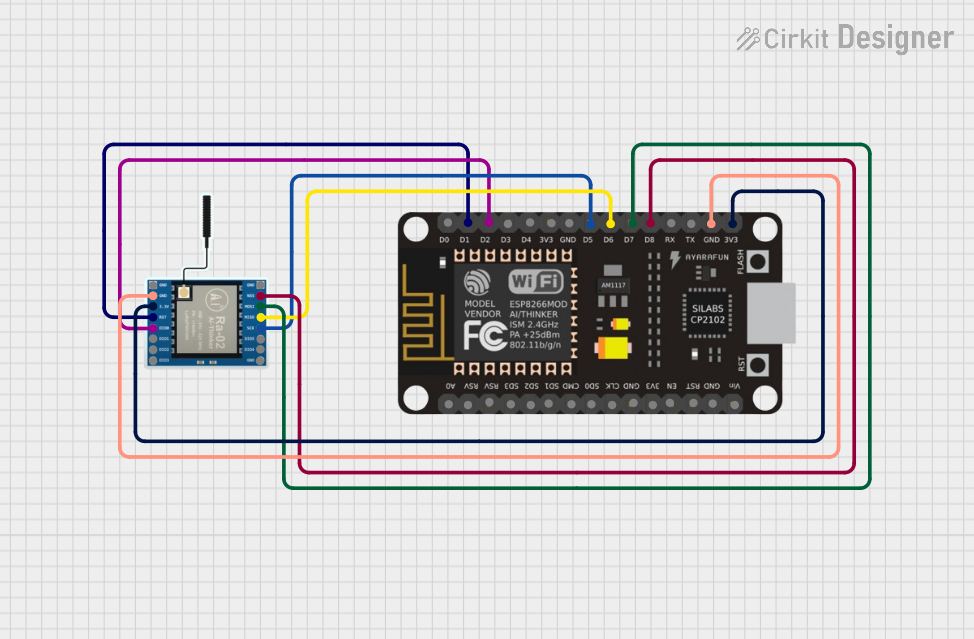
 Open Project in Cirkit Designer
Open Project in Cirkit Designer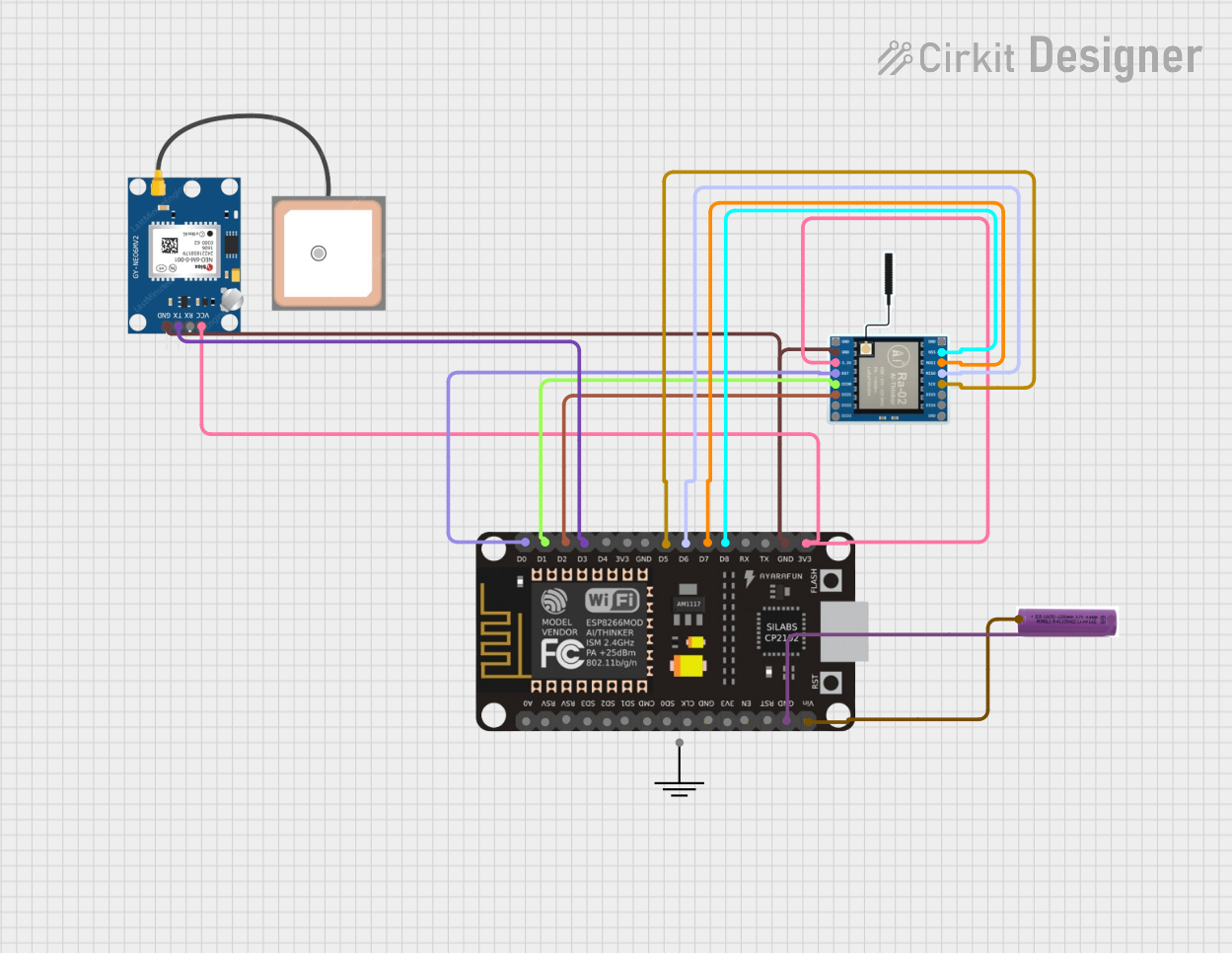
 Open Project in Cirkit Designer
Open Project in Cirkit Designer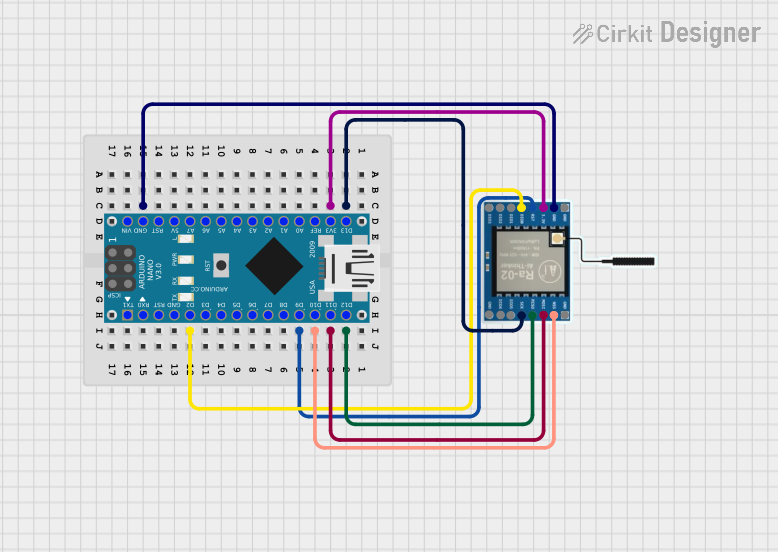
 Open Project in Cirkit Designer
Open Project in Cirkit Designer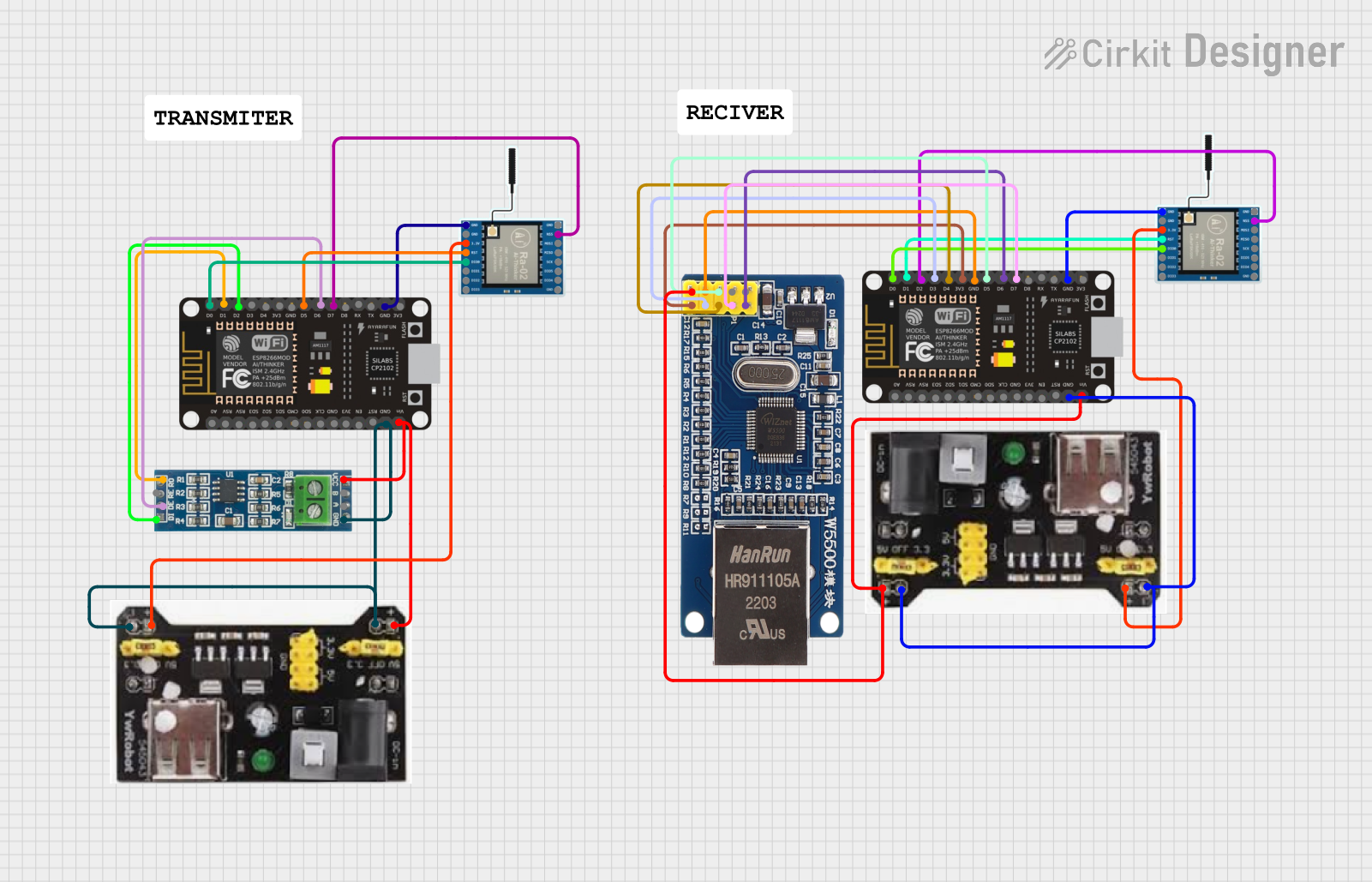
 Open Project in Cirkit Designer
Open Project in Cirkit DesignerExplore Projects Built with LoRa 433mhz SX1278 Ra-02

 Open Project in Cirkit Designer
Open Project in Cirkit Designer
 Open Project in Cirkit Designer
Open Project in Cirkit Designer
 Open Project in Cirkit Designer
Open Project in Cirkit Designer
 Open Project in Cirkit Designer
Open Project in Cirkit DesignerCommon Applications and Use Cases
- Smart agriculture (e.g., soil moisture monitoring, weather stations)
- Industrial automation and monitoring
- Smart cities (e.g., parking sensors, street lighting control)
- Remote data logging and telemetry
- Home automation and security systems
- Wireless sensor networks
Technical Specifications
The following table outlines the key technical details of the LoRa 433MHz SX1278 Ra-02 module:
| Parameter | Value |
|---|---|
| Frequency Range | 433 MHz |
| Modulation Technique | LoRa (Long Range) |
| Communication Range | Up to 10 km (line of sight) |
| Operating Voltage | 1.8V to 3.7V |
| Operating Current | 10.8 mA (transmit), 10.3 mA (receive) |
| Sleep Current | < 200 nA |
| Data Rate | 0.018 kbps to 37.5 kbps |
| Sensitivity | -148 dBm |
| Output Power | Up to +20 dBm |
| Interface | SPI |
| Operating Temperature | -40°C to +85°C |
| Dimensions | 16 mm x 16 mm x 2 mm |
Pin Configuration and Descriptions
The SX1278 Ra-02 module has 16 pins. The table below describes each pin:
| Pin Number | Pin Name | Description |
|---|---|---|
| 1 | GND | Ground connection |
| 2 | DIO5 | Digital I/O pin 5 |
| 3 | DIO4 | Digital I/O pin 4 |
| 4 | DIO3 | Digital I/O pin 3 |
| 5 | DIO2 | Digital I/O pin 2 |
| 6 | DIO1 | Digital I/O pin 1 |
| 7 | DIO0 | Digital I/O pin 0 (used for interrupts) |
| 8 | NSS | SPI chip select (active low) |
| 9 | SCK | SPI clock input |
| 10 | MOSI | SPI master-out, slave-in |
| 11 | MISO | SPI master-in, slave-out |
| 12 | GND | Ground connection |
| 13 | 3.3V | Power supply (3.3V) |
| 14 | RESET | Reset pin (active low) |
| 15 | ANT | Antenna connection |
| 16 | GND | Ground connection |
Usage Instructions
How to Use the Component in a Circuit
- Power Supply: Connect the
3.3Vpin to a regulated 3.3V power source and theGNDpins to ground. - SPI Interface: Connect the
NSS,SCK,MOSI, andMISOpins to the corresponding SPI pins on your microcontroller. - Antenna: Attach a 433 MHz antenna to the
ANTpin for optimal signal transmission and reception. - Interrupts: Use the
DIOpins for handling interrupts, depending on your application. - Reset: Connect the
RESETpin to a GPIO pin on your microcontroller for resetting the module when needed.
Important Considerations and Best Practices
- Voltage Levels: Ensure the module operates within its voltage range (1.8V to 3.7V). Use a level shifter if interfacing with a 5V microcontroller.
- Antenna Placement: Place the antenna away from metal objects and other sources of interference for maximum range.
- SPI Configuration: Configure the SPI interface with the correct settings (e.g., clock polarity and phase) as required by the module.
- Power Consumption: Use the sleep mode to minimize power consumption in battery-powered applications.
- Regulatory Compliance: Ensure compliance with local regulations for operating on the 433 MHz frequency.
Example Code for Arduino UNO
Below is an example of how to interface the SX1278 Ra-02 module with an Arduino UNO using the LoRa library:
#include <SPI.h>
#include <LoRa.h>
// Define LoRa module pins
#define NSS 10 // SPI chip select
#define RESET 9 // Reset pin
#define DIO0 2 // Interrupt pin
void setup() {
// Initialize serial communication for debugging
Serial.begin(9600);
while (!Serial);
Serial.println("Initializing LoRa module...");
// Initialize LoRa module
LoRa.setPins(NSS, RESET, DIO0); // Set SPI and control pins
if (!LoRa.begin(433E6)) { // Initialize at 433 MHz
Serial.println("LoRa initialization failed!");
while (1);
}
Serial.println("LoRa initialized successfully!");
}
void loop() {
// Send a test message
Serial.println("Sending message...");
LoRa.beginPacket(); // Start a new packet
LoRa.print("Hello, LoRa!"); // Add data to the packet
LoRa.endPacket(); // Send the packet
delay(5000); // Wait 5 seconds before sending again
}
Notes:
- Install the
LoRalibrary in the Arduino IDE via the Library Manager before running the code. - Connect the
NSS,RESET, andDIO0pins to the Arduino UNO as defined in the code.
Troubleshooting and FAQs
Common Issues and Solutions
LoRa Module Not Initializing
- Cause: Incorrect wiring or SPI configuration.
- Solution: Double-check the connections and ensure the SPI pins are correctly assigned in the code.
Short Communication Range
- Cause: Poor antenna placement or interference.
- Solution: Use a high-quality 433 MHz antenna and place it away from obstructions or interference sources.
High Power Consumption
- Cause: Module not entering sleep mode.
- Solution: Use the sleep mode feature in your code to reduce power consumption when the module is idle.
No Data Received
- Cause: Mismatched frequency or settings between transmitter and receiver.
- Solution: Ensure both modules are configured with the same frequency, bandwidth, and spreading factor.
FAQs
Q: Can I use the SX1278 Ra-02 with a 5V microcontroller?
A: Yes, but you must use a level shifter to convert the 5V logic levels to 3.3V to avoid damaging the module.
Q: What is the maximum range of the SX1278 Ra-02?
A: The module can achieve up to 10 km range in line-of-sight conditions. However, obstacles and interference may reduce the range.
Q: Can I use multiple SX1278 modules in the same network?
A: Yes, you can use multiple modules, but ensure they operate on the same frequency and settings for communication.
Q: How do I improve signal quality?
A: Use a high-gain antenna, minimize interference, and ensure proper grounding for the module.